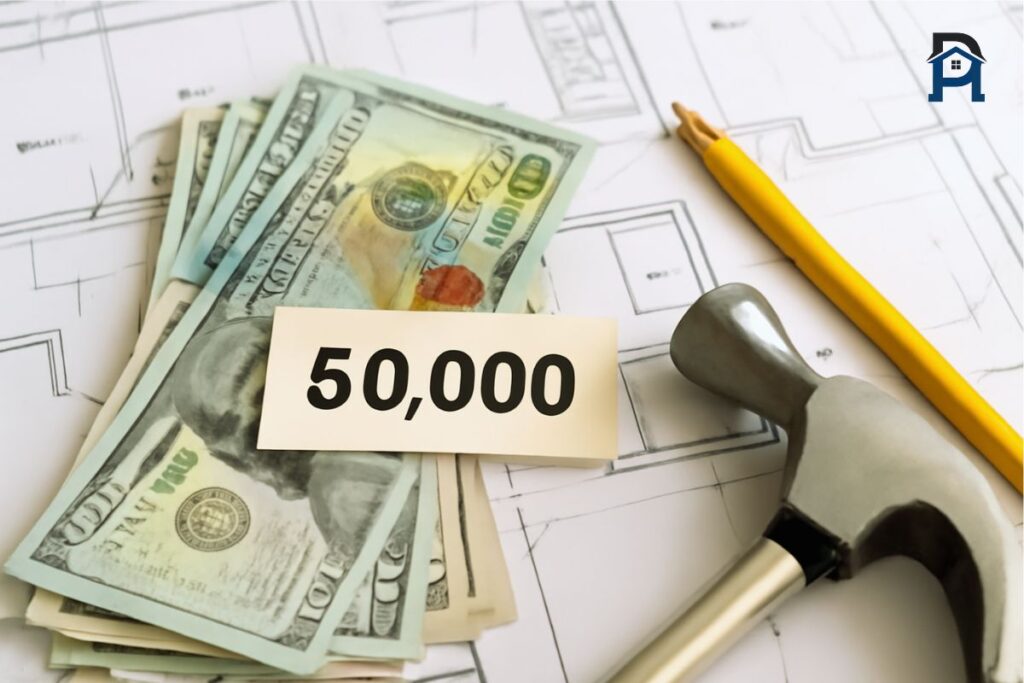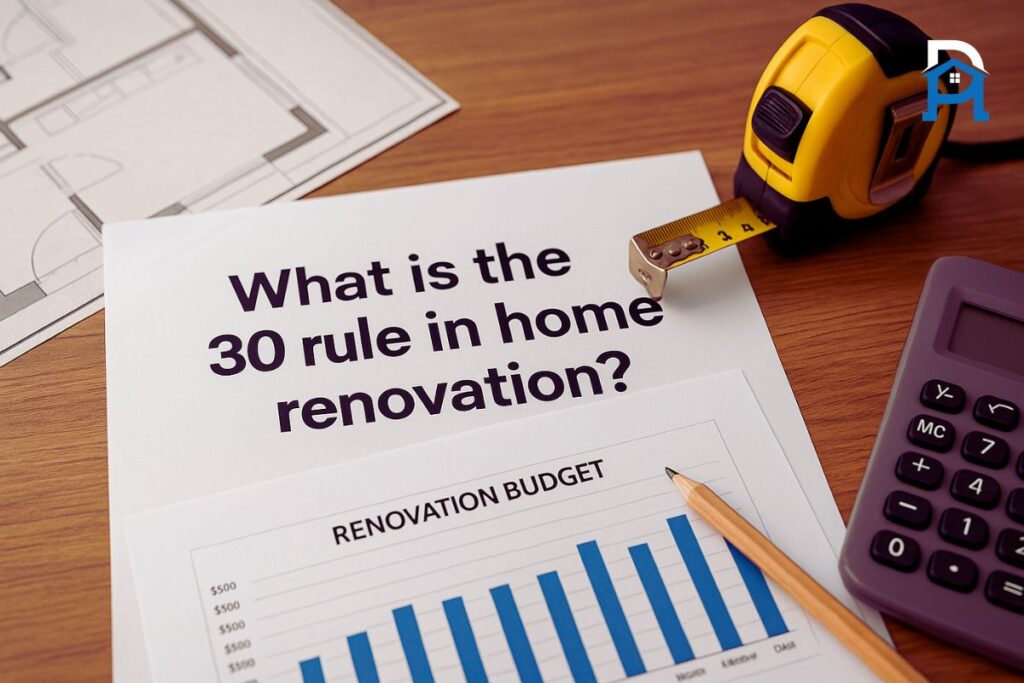After more than fifteen years in the renovation game, I’ve learned that a budget of $50,000 can truly transform a small fixer-upper, as long as every dollar gets the attention it deserves. Your best first step is to pinpoint the spots that will give you the most bang for your buck-the kitchen, the bathroom, maybe the front porch-and then hunt for smart, budget-friendly ideas that stretch each cent.
You don’t need a tear-down to feel like you have a new home. Often a coat of paint, updated knobs, or a fresher layout is enough to wake up a weary room, and when you use leftover materials or stick with simple finishes, those little tweaks stay well within range.
I always remind clients that renovations are both a personal adventure and a way to build value; you get to enjoy the space you love now while boosting equity for the future.
Sure, the thought of tearing into drywall can sound intimidating, but with a step-by-step plan, clear goals, and a bit of patience, you can upgrade your house and actually have fun without emptying your wallet.
Key Takeaways
- A $50,000 budget can cover many essential renovations that improve both function and style.
- Focus on kitchens and bathrooms to get a strong return on investment.
- Create a detailed budget that includes materials, labor, permits, and a contingency fund for unexpected costs.
- Always prioritize structural repairs and urgent needs before aesthetic improvements.
- Track budget effectiveness by monitoring how much labor costs impact your spending.
- Get multiple contractor quotes to compare pricing and avoid overspending.
- Build in flexibility with your timelines to take advantage of better prices.
- Plan during off-peak renovation seasons for cost savings and easier scheduling.
Can You Renovate a House for $50,000?
New homeowners whether they ve just bought their first bungalow or landed a cheap Victorian often wonder if 50,000 is enough cash to revive a tired place. The honest answer is that it really depends on what you want to do, where you live, and how much elbow grease you’re willing to invest. Most owners skip the giant jobs adding a new bathroom or gutting the kitchen and instead tackle smaller upgrades that, added together, give the whole house a fresh feel. Switching out light fixtures laying down vinyl plank giving the walls a bright coat of paint and refreshing the cabinets wouldn’t t win a magazine spread on their own yet they pull everything together into a space that feels clean, cheerful, and welcoming.
On move-in day many buyers grab their notebooks, set a rough order of attack, and start chipping away within weeks. They usually have two simple goals make the place theirs and make it easier to sell later. Because style is personal sticking to a written list and choosing middle-ground options a vintage-style knob instead of a high-end one, or a smart-light pendant rather than a custom fixture helps keep overspending in check. When smart swaps meet steady patience a 50,000 budget can boost curb appeal, seal hidden leaks, and turn a drafty fixer into a livable, market-ready home.
Home Renovation Options
When you have about 50,000 set aside for upgrades, the first step is figuring out what matters most and where you can make the biggest difference. Grab a notepad and walk through every room; jot down spots that feel dated, worn, or just plain annoying, then rank those needs by how they affect day-to-day life and resale value.
Small swaps can save big cash. Instead of solid hardwood, think quality laminate; pick a stylish, budget-friendly bathroom vanity rather than a high-end custom piece. That way you stretch every dollar spent on materials and labor.
Usually, fresh paint, new light fixtures, and fresh tile beat big jobs like moving walls when it comes to impact per dollar. Keep learning about your choices, stick to your plan, and you should end every task feeling proud and still financially healthy.
Deciding Which Parts of Your Home to Reinvent
Before you grab a paint brush or call a contractor, take a quiet minute to figure out what really matters to you. Jot down rooms that feel cramped, look dated, or just seem plain blah, then ask yourself how each one affects your daily routine. Giving each area a quick score-from must-fix to nice-to-have-keeps your budget in check when material prices and labor costs start going up.
If you want the biggest bang for your buck, focus on high-impact spots like the kitchen, bathroom, and entryway. Small upgrades-fresh paint, solid cabinet hardware, or a few energy-saving bulbs-transform tired corners into showpieces without emptying your wallet. Once these key areas sparkle, you get a clearer picture of the final look and a safe map for any bigger changes that might come later.
Inside or Outside- Where Should the Work Start?
Your first big question is simple: should you fix what shows on the outside or the stuff nobody sees until they walk in? It really comes down to how your house feels right now. Jagged shingles, dull siding, or flaking trim can scare buyers off long before they reach your sparkling living room, so curb-appetite jobs usually take top billing. On the other hand, if dripping faucets, cracked tiles, or beige walls are ruining your own daily comfort, an overhaul indoors suddenly seems a whole lot more urgent.
Still not sure what comes first? An experienced contractor can chat with you about budget limits, set aside materials, and doodle a timeline that lifts value without emptying your wallet. Once the starting line is clear, each swing of the hammer and swipe of the brush brings your dream closer and makes living in the house fun again.
Can You Get a Brand-New Kitchen for Less Than $50K?
Absolutely, you can give your kitchen a bright, modern feel for well under fifty grand-as long as you pick smart upgrades and stick to that plan. Cost-friendly moves like repainting cabinets, swapping out knobs, and adding a cheerful backsplash or budget counter-tops can freshen the space fast without draining your wallet.
Picking mid-range appliances and basic light fixtures keeps costs in check, especially if you stick with the same layout and plumbing. Contractors often say that kitchen upgrades recoup most of their value at sale time, which is why many landlords pour money into this room first.
Little changes-a cheerful paint color, a modern sink, or new drawer pulls-can completely lift how the kitchen looks and feels. Agents hear it over and over: kitchens sell houses, and fresh style stops buyers from drifting toward the next listing.
Cost-Effective Kitchen Remodeling Ideas
With about $50,000 to work with, you can still make smart moves that keep your wallet happy. Replacing old cabinets or simply repainting them gives the room that new-feeling pop without the heavy toll. Add open shelves, quirky storage tricks, and budget-friendly fixtures, and you bring light and trendy flair in a heartbeat.
If you want to cut monthly bills, choose energy-saving cooktops, dishwashers, and fridges. Pair those with tough countertops such as laminate or quartz, and the whole kitchen stays sleek. Smart homeowners spread budget across backsplashes, floors, and minor upgrades instead of tearing everything out, often seeing good returns when they sell. So whether you set aside 15,000, 15,000, or 20,000, fresh, stylish appliances are always a win that future buyers will notice.
When cabinets show their age, a quick satin coat, light refinishing, or even leaving them as-is can keep expenses low. The trick is sorting what must go from what just needs a polish while pulling in a few DIY skills where you feel ready.
The Bathroom
The bathroom ranks near the top of must-see spaces in any home. Right after the kitchen, a clean, modern bath can catch buyer’s eyes and lift your houses value fast. The good news is you don’t need deep pockets to create that wow; a new paint color, fresh towel bars, updated faucets, or brighter bulbs can boost mood in minutes and for little cash.
When trends pass or your tub and toilet look dull, swapping a few key parts lifts the whole bathroom fast. A typical mid-level update runs between 2,500and2,500and4,200, but hunting for budget-friendly sinks, fresh tile, or a simple vanity lets you steal the show without breaking the bank.
Stick to soft, neutral colors if you want that clean hotel look buyers adore, and that can help your house sell faster. The trick is to renovate smart: research products, plan labor time, total all costs, and do the easy jobs yourself so your budget stays steady.
Upgrade Your Living Room
Give your living room a fresh feel and you usually dodge the fuss of a bathroom or kitchen redo. You don’t need to move pipes or buy fancy fixtures, so you focus on the floor, walls, and ceiling. Change those parts and the mood shifts, making the space cozier, easier on the eyes, and full of welcome.
A Variety of Flooring Options
You don’t need a huge budget to give your living room floors the upgrade they deserve. Basic pine boards look fresh with a coat of paint, bang out an easy clean routine, and cheer up the room in seconds. If you want the classic feel, wide oak or maple planks give off warmth and old-home charm that never goes out of style. Linn-tile versions of cork, bamboo, and vinyl now copy those natural grains or even stone surfaces nearly as well and cost a fraction as much, leaving you extra cash for the next project.
Change Up the Lighting
Swapping dingy overheads for brighter bulbs is still the quickest and cheapest style fix a homeowner can make. Spend a little on warm-white LEDS and watch your power bills shrink over the months, plus they last almost ten years. Add motion-sensitive exteriors that fire up when guests stroll in or a battery-light step fixture over the porch edge for safety at night while keeping bulbs out of the muddy shine. Inside, a bold drum fixture above the breakfast bar or a faded brass snooker-style lamp above the dining table dresses everyday spaces in seconds without a pro handy-man.
Expanding Your Outdoor Space
With a $50,000 budget, you can turn your yard into a room that’s stylish, useful, and raises the homes worth at the same time. Whether you pick a roomy stone patio, a classic deck, or a breezy pergola, lining the new structure with flowers and hardy shrubs ties the scene together. Add a pop-up fire pit, string lights, and a couple of weatherproof cushions and the quiet corner becomes the family’s movie night spot, Sunday brunch area, or late-night reading retreat.
Adding a Deck or Pergola
Renovating an old deck or building a fresh one turns the yard into a comfy hangout for family and friends, and choose the right spot and design and you will enjoy that space for years. Just know that every material-wood, composite, or vinyl-brings its own upkeep cost, and those costs can change depending on local weather and how much sun, rain, or snow it soaks up.
A simple pergola gives any seating area a nice defined shape while keeping the space from feeling closed in. You can grab an affordable kit if you need speed, or order a custom build in cedar, redwood, or another special species when those details matter. Once you top it with lattice, hang string lights, or let vines drape over the slats, the frame stays open but still adds that little wow moment.
Upgrade Your Landscaping or Hardscaping
With roughly 50,000 dollars to spend, fresh landscaping and hardscaping open the door to bigger projects that can turn a plain yard into a staycation spot. Walkways, steps, and patios made from pavers, stamped concrete, or porcelain tile now come in bold colors, eye-catching patterns, and tough finishes that resist chipping, fading, and cracking for years.
Adding a stain or stamp to the surface can copy the look of wood grain or marble at a fraction of the real materials cost. Installing a fountain, running new irrigation, or building tiered plant beds each lands somewhere between 5,000 and 20,000 dollars, so make a wish list first and pace the work to protect your wallet.
Landscaping and Exteriors
If you flip houses for a living or just help friends get theirs ready to sell, you already know first impressions matter. Stand at the front door for a second and imagine what a buyer sees- gravel bit where grass should be, thin little shrubs, or a fence that leans like it needs a nap. Even a pricey home can seem worn out if the yard looks ignored.
Spending around 3,000 dollars buys fresh seed, enough top-soil to not muddy your shoes, and hardy shrubs that almost plant themselves. Shape the hedges, pinch in a few bright annuals, keep the grass short, and suddenly the yard greets visitors instead of hiding in the shadows.
Paint old shutters, tighten gutters that spill water like a bad roof, and either reseal a cracked driveway or lay down simple pavers. Power-wash the steps, polish the windows, peek at wooden frames for soft spots, and at last the outside starts to shout, “Hey, I’m ready to sell.”
Deck Space
A big wooden deck adds instant hang-out space buyers adore, especially younger couples and families dreaming of lazy Saturdays or easy cookouts.
Adding a deck bumps your home s square footage, so a simple design starts around 1,000 and a fancier build by pro crews can go to 8,000 or even more.
Plan any deck with your local weather in mind, choosing wood or composite that seals well, shrugs off rain, and takes a fresh stain every few years so it stays strong.
Composite boards mix wood waste with plastic, making them resist rot, need almost no upkeep, and match the green trend buyers like when you sell.
The Fireplace
In chilly parts of the country, houses that offer a wood-burning fireplace quickly grab an eye-and often a bid-from buyers who see firelight as a bit of everyday luxury.
Sure, putting in a brand-new unit for a freshly built home can sting price-wise, yet if the brickwork and flue are already there, updating or refacing the old hearth usually costs only 300to300to2,000, depending on whether you swing the hammer yourself or call in a pro.
To keep the bill lean without skimping on style, simple touches like a fresh coat of paint, a carved mantle piece, or a glass fire screen can change the feel of the room for next to nothing. And for warm-weather evenings, a small outdoor fireplace or stone fire pit near the deck ties the yard together and keeps flames away from fragile flowers.
A Home That Fits Your Life
Your home is more than a roof and four walls; its the kitchen table where homework happens, the hallway where you race the dog, and the quiet corner where coffee tastes better- so it makes sense to move the plan around instead of moving houses when life shifts.
By choosing a full-house remodel rather than folding boxes, you rewrite that daily story in rooms that flow, gadgets that work, and light that lifts moods, letting you fall in love with the space all over again without losing your friends down the street.
Understanding Renovation Costs
Every time you plan to fix or update part of your home, money is the first thing you need to think about. A good budget matches what you want done with what you can afford and tells you where to start and stop. To that base number, add costs for materials, workers, any needed permits, and at least an extra 10 to 20 percent to cover those odd expenses that always pop up.
How much a job actually costs depends on where you live and how big or small the work is. Extras such as blueprints or hiring a designer tend to sneak in and push the total higher. Working with a team like Prime Work Construction brings years of experience, keeps prices clear, and helps you stay on track without losing quality. Spend on fixes that raise your homes value, resist the urge to skimp, and stretch each dollar for results you can enjoy for years.
Assessing Your Homes Current Condition
Before you swing a hammer or order paint, walk through your house and note every crack, leak, and shadow that feels tired or broken. Some problems must be fixed first, while others show only cosmetic wear, so spotting them early shows where money really needs to go-and where it doesnt.
Once you have a list, compare it with your budget to steer clear of surprises halfway through the job. For larger plans, invite a trained pro to inspect the roof, wiring, and plumbing, and give you a written estimate that spells out costs, timelines, and what happens if new issues turn up. по-русски
Evaluate Structural Integrity
Before spending on renovations, make sure your foundation, roof, and walls are truly solid. Walk the perimeter looking for cracks where the wall meets the ground, watch for bulging or bowing in interior and exterior walls, and examine the roof for sagging areas, curling shingles, or dark streaks that can signal leaks. Finally, move from room to room, stepping across each floor board; uneven spots or sections that feel soft underfoot often hint at deeper issues hidden beneath the surface.
Identify Necessary Repairs
Begin with an honest whole-house walk-through, looking room by room for obvious clues like water stains, gaps around windows, or sagging ceilings. Peek under sinks for rusty pipes or puddles, feel for cold drafts around door frames, and listen for any buzz or flicker from lights that hint at wiring trouble. Jot down every small and big problem, rank them by urgency, and tackle safety threats or anything that could undermine your homes frame before making cosmetic changes.
Aesthetic Improvements Matter
When you look around your home, it’s easy to get lost in big structural fixes like roofs and wiring. Yet lighter updates can lift the mood just as powerfully and for much less money. A fresh paint job softens wall scars and instantly changes a room’s warmth; swapping dull fixtures or adding a few LED bulbs rewards the eye and the electric bill at once.
Outside, tidy flower beds, a small patch of grass, or two lanterns on the porch make passing delivery drivers say, wow. New vinyl planks, refinished hardwood, or clean wall-to-wall carpet under bare feet do the same for family and guests.
Prioritize by Impact
Renovating without a plan is like pouring-$50,000-worth of salt on soup you can’t taste yet. Start with fixes that keep the house standing- cracks, leaks, or old wiring- because nobody enjoys cooking in a smoky kitchen or chilling in a sagging man cave.
Once safety is locked in, turn toward rooms that feel cramped or tired. A smart contractor knows how to reshuffle walls or swap cabinets, especially in kitchens and bathrooms, so ask one early and follow their timeline. After the essentials, sprinkle in the color and charm, remembering each swipe of paint or shiny faucet is really a promise that this home stays with you for years.
Cost Breakdown: What to Expect
Planning a home renovation is more than dreaming about new tile or open spaces. When you give each part of the job a clear, honest dollar amount, you keep the work moving forward and avoid last-minute money panic. So, list the cost of materials, the price of labor, and then tuck away 10 to 15 percent for the surprises no one wants but every project seems to find.
A solid walk-through with a builder or engineer will spot hidden leaks, cracks, or rotten beams before you swing a hammer. Fixing these early keeps the schedule tidy and your waiting room free of leaks.
Essential Renovation Areas
Spending $50,000 wisely can turn an ordinary house into a comfortable home that works for your family. By picking rooms that matter most or that buyers look at first, you stretch every dollar and raise your day-to-day enjoyment. The kitchen remains the star, so new appliances and painted or refaced cabinets usually give the biggest punch because they blend better function with fresh beauty.
The bathroom benefits from updated faucets, a higher toilet, and better lighting; small upgrades can still lift comfort and resale value. A coat of soft paint and good-quality laminate or hardwood in the living room welcomes guests and relaxes kids, while fresh grass, tidy borders, or a simple porch light promise strangers a warm hello before they even ring the bell.
Material and Labor Costs
Renovating a house is exciting, but knowing how much materials and labor will really cost keeps your budget in the green. Every choice-from granite countertops to exotic hardwood floors-adds dollars fast, so pricing each item early is smart.
Hiring good contractors means the job gets done right and saves you headaches later, yet their fees can chew up 30 to 50 percent of your total pot. To keep costs fair, ask several pros for quotes, compare the details, and pick a team that balances price with skill.
Unexpected Expenses Considerations
No matter how careful the plan, surprises still appear, usually hiding behind walls or under floors, and fixing them can be pricey. Structural damage, old plumbing, or uncharted mold may pop up, so set aside an extra 10 to 15 percent of your budget for these hidden repairs.
Permits and inspections also cost money, yet newcomers often shrug those fees off until they arrive. Finally, choosing upgraded fixtures or slower-moving trades can stretch spending farther, especially when a skilled worker takes longer than expected.
Tips for Stretching Your Renovation Budget
When your renovation budget is around $50,000, the best way to stretch those dollars is to start with a clear list of must-do repairs, like updating the kitchen or fixing leaky plumbing, before moving to cosmetic upgrades.
Spend some time reading reviews, asking for bids from three or four contractors, and keep an eye out for local supply centers that sell gently used or clearance materials, since shopping that way can easily cut costs in half.
Hammering in trim or painting walls yourself saves big, and planning the project during slow months lets you negotiate better rates, while a 10%-15% cushion in a separate fund helps you handle surprises without derailing the whole plan.
Financing Options for Home Renovations
When you plan a home renovation, you have several ways to pay for the work. A home equity loan lets you borrow against the value you’ve built up, giving you a lump sum with a fixed interest rate that stays the same every month. If the project is smaller, a personal loan might fit better; it is unsecured and usually has a short approval time, but the rate can vary a lot.
Many homeowners grab a credit card for quick purchases, yet those high interest charges can bite hard if you do not pay the balance right away. For buyers of older houses, an FHA 203(k) loan rolls the cost of buying and repairing the home into one mortgage, making it easier to afford a fixer-upper. Wherever you live-can be Bay Area, Midwest, or South-hiring licensed and insured pros protects your budget and keeps the work up to local code.
Realistic Expectations for Your Renovation Project
Knowing what to expect from a $50,000 renovation lets you spread the money across practical updates. While the budget won’t turn your house into a mansion it can pay for solid improvements like a fresh kitchen and modern bathroom both of which usually boost resale value.
Start by listing repairs based on urgent needs and how much each costs then tackle the must-haves first. Set aside another 10 to 15 percent for surprise bills such as permit fees or overtime wages and draft a schedule that includes likely delays.
Keep the lines open with your contractors and think about hiring a bathroom specialist if that room gets a major overhaul. Plan well and you can enjoy the upgrades without overspending.
Frequently Asked Questions
Can DIY renovations really save money?
Yes, if you read, watch videos, and measure twice before cutting. The biggest savings come when you dodge mistakes that force you to pay a pro to fix them.
What permits are required for home renovations?
It varies by town but common ones are for framing, electrical work, and plumbing. A quick call to your local building department will clear up what you need.
How do I choose a reliable contractor?
Finding a trustworthy contractor starts with checking their licenses, insurance, and industry awards, then moving on to read recent customer reviews and ask your friends or neighbors who they recommend. You should also see photos or videos of similar jobs they’ve done and talk with them about how long they’ve been in business and any challenges they tackled during past projects.
What are common mistakes to avoid during renovations?
House work usually goes sideways when owners underestimate expenses, skip permits, ignore small details, or race to decisions under pressure. Make a habit of asking questions, keeping notes, and having regular check-ins so everyone agrees on the plan and the quality stays high from start to finish.
How can I increase my home’s value after renovation?
Projects that pay off most at sale time include a fresh, stylish kitchen, a spa-like bathroom, an appealing front yard, and smart upgrades like LED lights or a new furnace. Buyers notice these features quickly, which can push your listing price up and make your home stand out.
Final Thoughts
When budgeting $50,000 for a new-house overhaul, local labor rates, the size of each room, and material choices all play huge roles. Jumping in yourself on easy jobs, such as painting or landscaping, can trim the bill, but know when serious rewiring or plumbing work needs a pro. Thoughtful fixes in big-impact spots like kitchens and baths still give the best return, so list items to toss, items to freshen up, and don’t forget the outside, where first impressions are made quickly.
At Dwellify Home, we believe that with the right vision and a smart approach, every dollar counts—and $50,000 can be the start of something truly beautiful.
Disclaimer: This article provides general information on renovating a house with a $50,000 budget. It is not professional financial, design, or construction advice. Actual costs can vary based on location, materials, labor, and project scope. Always consult qualified experts before starting any renovation project.

I’m Bilal, the founder of this site dwellifyhome.com and a home remodeling expert. From décor ideas and renovation tips to smart solutions for everyday comfort, our goal is to make your home more beautiful, functional, and inspiring. We’re here to share practical advice and fresh inspiration for every corner of your house.




